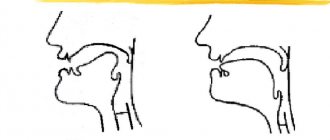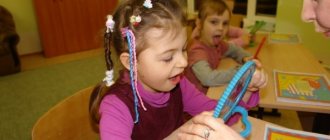Greetings, dear readers and subscribers of my blog! Guess what the connection is between the steamboat, the sail and the turkey? Does the steamboat have a sail and is carrying a turkey? Not quite so, although it was probably on such ships that these domestic birds were brought to us from the New World. The solution will help to reveal all the ways and techniques for setting the sound of L.
In this article I hasten to continue the topic started earlier. And after reading the article to the end, you will find the answer to this and other questions, but first things first. At the beginning of his work on sound, the speech therapist finds out how it is disrupted and what problems the child has with its pronunciation.
Does he have dysarthria? Are the adenoids enlarged? Is everything good with his ENT organs, breathing, voice? The L sound is solid and sonorous. After diagnosis and during preparatory classes, you can already decide on methods and methods for correcting lambdacism. And what tools and auxiliary materials may be useful at this stage.
By imitation
A fairy tale about a small steamboat.
Once upon a time there lived a little steamboat, Mickey, who didn’t want to blow his whistle. His mother told him how bad it was, well-mannered boats always honk if they meet other boats on their way. Dad said: “You are so small, they might not notice you in the fog.” One day the following story happened: Mickey got lost. He started playing with funny colorful fish that jumped out of the water. I didn’t notice how the fog rose. He wanted to buzz, but he couldn’t. Let's show him how to buzz.
Show how to lift the wide tongue (I) over the upper teeth (H). If it doesn’t work out, sit in front of the mirror with your baby and show him. Show on your hands - fold your palm into a cup, as if you want to scoop up water (this is Me) and rest it on the other palm, standing on its edge (teeth).
The steamboat is humming
The steamboat failed to make a sound. There is no wind, complete calm, the sail does not inflate. It doesn’t matter, I’ll try to row with oars. The paddles are wide (“shovel” - a wide tongue lies on the lower relaxed lip). The oars splash through the water (five-five-five and cha-cha-cha)
The simplest and most reliable method, if there are no complications such as dysarthria and adenoiditis. We squeeze the wide I between Z and try to pronounce the sounds Y or L. Sometimes it works right away. But sometimes you have to make preparations:
- spatula (pancake) - holding the wide I on the free lower lip - “pancake on a plate”, smoothly slide it into the mouth, stopping it between the teeth
- “knead the dough” - we slap the I with our lips “five-five-five” and teeth “cha-cha-cha”, then “cha-cha-cha” or “ta-ta-ta” (whatever happens) we translate into lalala or Lala, accordingly, tapping, we press the tongue with our teeth and pull “LLLLLL” and “LLLLL”
Breathing exercises
Exercises for setting L are combined with breathing techniques to enhance the effect:
- Inhale quickly and exhale smoothly;
- Blow on the turntable for as long as possible;
- Stop the running horse: take a breath, relax your lips, exhale the air to make the sound “prr”;
- Inflate the “ball”: lying on your back while inhaling, strongly protrude your stomach, while exhaling, “deflate”.
You can play a guessing game - ask your child, with his eyes closed, to guess fruits or other objects by smell. For correct setting, all tasks are performed while inhaling.
Sail
After the interdental L is fixed and the pronunciation becomes stable, you need to lift the I by the Z and move on to the “sail” method. When pronouncing L interdentally, the tongue should immediately be raised upward.
The breeze blew and the sail began to rise.
The method is also simple, but it is only suitable if the tongue is wide and held in the upper position. I lift up behind Z and buzz L or L. It is completely unsuitable if L is replaced with G or NG. To make the “sail” less convex, you can slightly push it with a cotton swab or probe. It is best to combine a sail and a steamer. Sound a horn, then say: “Now do the same, but with a sail,” help with a stick and make sure that the mouth does not close; you can hold the “sleigh” probe between the side teeth.
With mechanical support
But suddenly the mast breaks, the sail doesn’t rise, let’s help.
If the sail doesn’t work out in any way, but there is no replacement for the back tongue G, and it turns out to be a steamboat, then we ask the baby to lift the G by the upper W and hum like a steamboat. You can use a probe, a cotton swab or bread stick, the handle of a teaspoon or a toothbrush, everything must be clean and sterilized. This method is good for dysarthria, when the ego is poorly controlled due to impaired innervation, is poorly held or goes to the side.
Chatterbox, turkey babbles
This method works well when replacing “L” with “G” (NGN). And also for small children under the age of 5 years, since the sound L is difficult to produce and requires some volitional efforts and conscious, voluntary actions.
We quickly move the I forward and back with the tip along the upper lip, the lips are in a smile, the mouth is open, the sound is “blblbl”, we gradually slow down the movement, pronouncing “l-l-l” or “l-l-l”, then we hold the I longer behind the upper lips 3 in the “sail” position, the tongue strokes the upper front teeth from the inside, pronouncing “LLLL” or “LLLL”, then falls on the lip in the “pancake” position, pronouncing “A” or “E”. I should fall on the lip, and not go deep into the mouth.
Mickey swims by, and a turkey stands on the shore. Greets him and babbles. The turkey ran towards him. The steamboat looked at the turkey and began to row with an oar.
Article:
Whose teeth are cleaner? Target. Develop upward tongue movement and language proficiency. Description. Open your mouth wide and use the tip of your tongue to “brush” the inside of your upper teeth, moving your tongue from side to side. Attention! 1. Lips in a smile, upper and lower teeth visible.
2. Make sure that the tip of the tongue does not protrude or bend inward, but is located at the roots of the upper teeth. 3.The lower jaw is motionless; Only the language works. Painter. Target. Practice the upward movement of the tongue and its mobility. Description. Smile, open your mouth and “stroke” the roof of your mouth with the tip of your tongue, moving your tongue back and forth. Attention! 1.Lips and lower jaw should be motionless. 2. Make sure that the tip of the tongue reaches the inner surface of the upper teeth as it moves forward and does not protrude from the mouth.
Who will kick the ball further? Target. Produce a smooth, long-lasting, continuous air stream running down the middle of the tongue. Description. Smile, place the wide front edge of your tongue on your lower lip and, as if pronouncing the sound f , blow the cotton wool onto the opposite edge of the table. Attention! 1.The lower lip should not be pulled over the lower teeth. 2. You can’t puff out your cheeks. 3. Make sure that the child pronounces the sound f and not the sound x , i.e. so that the air stream is narrow and not diffuse.
Delicious jam. Target. Develop an upward movement of the wide front part of the tongue and a position of the tongue close to the shape of a cup, which it takes when pronouncing hissing sounds. Description. Open your mouth slightly and lick your upper lip with the wide front edge of your tongue, moving your tongue from top to bottom, but not from side to side. Attention! 1. Make sure that only the tongue works, and the lower jaw does not help, does not “pull” the tongue upward - it must be motionless (you can hold it with your finger). 2. The tongue should be wide, its side edges touch the corners of the mouth. 3.If the exercise does not work, you need to return to the exercise “Punish a naughty tongue.” As soon as the tongue becomes spread out, you need to lift it up and wrap it over the upper lip.
Turkey. Target. Develop the upward movement of the tongue and the mobility of its front part. Description. Open your mouth slightly, put your tongue on your upper lip and move the wide front edge of your tongue along your upper lip back and forth, trying not to lift your tongue from your lip - as if stroking it. First, make slow movements, then speed up the pace and add your voice until you hear bl-bl (like a turkey babbling). Attention! 1. Make sure that the tongue is wide and does not narrow. 2. So that the movements of the tongue are back and forth, and not from side to side. 3. The tongue should “lick” the upper lip, and not be thrown forward.
Drum (Drummers). Target. Strengthen the muscles of the tip of the tongue, develop the ability to lift the tongue upward and the ability to make the tip of the tongue tense. Description. Smile, open your mouth and tap the tip of your tongue on the upper alveoli, repeatedly and clearly pronouncing a sound reminiscent of the English sound d : ddd... First, pronounce the sound d slowly, gradually speed up the pace. Attention! 1. The mouth should be open all the time, lips in a smile, lower jaw motionless; Only the language works. 2. Make sure that the sound d has the character of a clear blow - not squelching. 3.The tip of the tongue should not curl up. 4. The sound d must be pronounced so that the exhaled air stream is felt. To do this, you need to bring a piece of cotton wool to your mouth. If the exercise is performed correctly, it will deviate.
A set of exercises to develop the correct pronunciation of the sound L.
Before you start performing the exercises, be sure to read the recommendations for performing articulatory gymnastics.
Punish the naughty tongue. Target. Develop the ability to relax the muscles of the tongue and hold it wide and spread out. Description. Open your mouth slightly, calmly place your tongue on your lower lip and, smacking it with your lips, pronounce the sounds five-five-five... Keep your wide tongue in a calm position, with your mouth open, counting from one to five to ten. Attention! 1.The lower lip should not be tucked in or pulled over the lower teeth. 2.The tongue should be wide, its edges touching the corners of the mouth. 3. You need to pat your tongue with your lips several times in one exhalation. Make sure that the child does not hold back the exhaled air. You can check the implementation like this: bring the cotton wool to the child’s mouth; if he does the exercise correctly, it will deviate. At the same time, this exercise promotes the development of a directed air stream.
Delicious jam. (Calyx) Purpose. Develop an upward movement of the wide front part of the tongue and a tongue position close to the shape of a cup. Description. Open your mouth slightly and lick your upper lip with the wide front edge of your tongue, moving your tongue from top to bottom, but not from side to side. Attention! 1. Make sure that only the tongue works, and the lower jaw does not help, does not “pull” the tongue upward - it must be motionless (you can hold it with your finger). 2. The tongue should be wide, its side edges touch the corners of the mouth. 3.If the exercise does not work, you need to return to the exercise “Punish a naughty tongue.” As soon as the tongue becomes spread out, you need to lift it up and wrap it over the upper lip.
The steamer is humming. Target. Develop an upward lift of the back of the tongue. Description. Open your mouth slightly and pronounce the sound y (like the hum of a steamship). Attention! Make sure that the tip of the tongue is lowered and located in the depths of the mouth, and the back is raised towards the sky.
Turkey. Target. Develop the upward movement of the tongue and the mobility of its front part. Description. Open your mouth slightly, put your tongue on your upper lip and move the wide front edge of your tongue along your upper lip back and forth, trying not to lift your tongue from your lip - as if stroking it. First, make slow movements, then speed up the pace and add your voice until you hear bl-bl (like a turkey babbling). Attention! 1. Make sure that the tongue is wide and does not narrow. 2. So that the movements of the tongue are back and forth, and not from side to side. 3. The tongue should “lick” the upper lip, and not be thrown forward.
Swing. Target. Develop the ability to quickly change the position of the tongue, which is necessary when combining the sound l with the vowels a, s, o, u . Description. Smile, show your teeth, open your mouth slightly, put your wide tongue behind your lower teeth (from the inside) and hold in this position for a count of one to five. So alternately change the position of the tongue 4-6 times. Attention! Make sure that only the tongue works, and the lower jaw and lips remain motionless.
Horse. (Click the tongue) Target. Strengthen the muscles of the tongue and develop the upward movement of the tongue. Description. Smile, show your teeth, open your mouth slightly and click the tip of your tongue (like a horse clicking its hooves). Attention! 1. The exercise is first performed at a slow pace, then faster. 2.The lower jaw should not move; Only the language works. 3. Make sure that the tip of the tongue does not turn inward, i.e. so that the child clicks his tongue rather than smacking.
The horse rides quietly. Target. Develop an upward movement of the tongue and help the child determine the place of the tongue when pronouncing the sound l. Description. The child should make the same movements with his tongue as in the previous exercise, only silently. Attention! 1. Make sure that the lower jaw and lips are motionless: only the tongue performs the exercise. 2.The tip of the tongue should not bend inward. 3.The tip of the tongue rests on the palate behind the upper teeth, and does not protrude from the mouth.
The breeze is blowing. Target. Produce an air stream coming out along the edges of the tongue. Description. Smile, open your mouth slightly, bite the tip of your tongue with your front teeth and blow. Check the presence and direction of the air stream with a cotton swab. Attention! Make sure that the air does not come out in the middle, but from the corners of the mouth.
A set of exercises to develop the correct pronunciation of hissing sounds.
Before you start performing the exercises, be sure to read the recommendations for performing articulatory gymnastics.
Punish the naughty tongue. Target. Develop the ability to relax the muscles of the tongue and hold it wide and spread out. Description. Open your mouth slightly, calmly place your tongue on your lower lip and, smacking it with your lips, pronounce the sounds five-five-five... Keep your wide tongue in a calm position, with your mouth open, counting from one to five to ten. Attention! 1.The lower lip should not be tucked in or pulled over the lower teeth. 2.The tongue should be wide, its edges touching the corners of the mouth. 3. You need to pat your tongue with your lips several times in one exhalation. Make sure that the child does not hold back the exhaled air. You can check the implementation like this: bring the cotton wool to the child’s mouth; if he does the exercise correctly, it will deviate. At the same time, this exercise promotes the development of a directed air stream.
Make your tongue broad. Target. Develop the ability to hold your tongue in a calm, relaxed position. Description. Smile, open your mouth slightly, place the wide front edge of your tongue on your lower lip. Hold it in this position for a count of one to five to ten. Attention! 1.Do not stretch your lips into a strong smile so that there is no tension. 2.Make sure that your lower lip does not curl up. 3.Do not stick your tongue out far; it should only cover your lower lip. 4. The lateral edges of the tongue should touch the corners of the mouth.
Glue on some candy. Target. Strengthen the muscles of the tongue and practice lifting the tongue upward. Description. Place the wide tip of your tongue on your lower lip. Place a thin piece of toffee on the very edge of your tongue and glue a piece of candy to the roof of your mouth behind your upper teeth. Attention! 1. Make sure that only the tongue works; the lower jaw must be motionless. 2.Open your mouth no wider than 1.5-2 cm. 3.If the lower jaw is involved in the movement, you can place the child’s clean index finger on the side between the molars (then it will not close the mouth). 4.The exercise must be performed at a slow pace.
Fungus. Target. Develop an upward lift of the tongue, stretching the hyoid ligament (frenulum). Description. Smile, show your teeth, open your mouth slightly and, pressing your wide tongue with its entire plane to the palate, open your mouth wide. (The tongue will resemble a thin mushroom cap, and the stretched hyoid ligament will resemble its stem.) Attention! 1. Make sure that your lips are in a smiling position. 2.The side edges of the tongue should be pressed equally tightly - neither half should fall down. 3.When repeating the exercise, you need to open your mouth wider.
Who will kick the ball further? Target. Produce a smooth, long-lasting, continuous air stream running down the middle of the tongue. Description. Smile, place the wide front edge of your tongue on your lower lip and, as if pronouncing the sound f for a long time, blow the cotton wool onto the opposite edge of the table. Attention! 1.The lower lip should not be pulled over the lower teeth. 2. You can’t puff out your cheeks. 3. Make sure that the child pronounces the sound f, and not the sound x, i.e. so that the air stream is narrow and not diffuse.
Delicious jam (Cup). Target. Develop an upward movement of the wide front part of the tongue and a position of the tongue close to the shape of a cup, which it takes when pronouncing hissing sounds. Description. Open your mouth slightly and lick your upper lip with the wide front edge of your tongue, moving your tongue from top to bottom, but not from side to side. Try to hold your tongue in this position for 5 to 10 seconds. Attention! 1. Make sure that only the tongue works, and the lower jaw does not help, does not “pull” the tongue upward - it must be motionless (you can hold it with your finger). 2. The tongue should be wide, its side edges touch the corners of the mouth. 3.If the exercise does not work, you need to return to the exercise “Punish a naughty tongue.” As soon as the tongue becomes spread out, you need to lift it up and wrap it over the upper lip.
Harmonic. Target. Strengthen the muscles of the tongue, stretch the hypoglossal ligament (frenulum). Description. Smile, open your mouth slightly, stick your tongue to the roof of your mouth and, without lowering your tongue, close and open your mouth (just as the bellows of an accordion stretch, so does the hyoid frenulum stretch). The lips are in a smiling position. When repeating the exercise, you should try to open your mouth wider and wider and keep your tongue in the upper position longer. Attention! 1. Make sure that when you open your mouth, your lips are motionless. 2.Open and close your mouth, holding it in each position for a count of three to ten. 3. Make sure that when you open your mouth, one side of the tongue does not sag.
Focus. Target. Develop the ability to lift the tongue upward, the ability to shape the tongue into a ladle and direct the air stream in the middle of the tongue. Description. Smile, open your mouth slightly, place the wide front edge of your tongue on your upper lip so that its side edges are pressed together and there is a groove in the middle of your tongue, and blow off the cotton wool placed on the tip of your nose. The air should go in the middle of the tongue, then the fleece will fly up. Attention! 1. Make sure that the lower jaw is motionless. 2.The lateral edges of the tongue should be pressed against the upper lip; a gap is formed in the middle into which an air stream flows. If this doesn't work, you can hold your tongue slightly. 3.The lower lip should not curl up or pull over the lower teeth.
A set of exercises to develop the correct pronunciation of the sound [H].
Glue on some candy. Target. Strengthening the muscles of the tongue and practicing lifting the tongue up. Description. The mouth is open 1.5-2 cm. The tongue is spread wide and rests calmly on the lower lip. Place a small piece of toffee on the very tip of your tongue and glue the candy to the roof of your mouth behind your upper teeth. We perform the exercise at a slow pace. Attention! During the exercise, you must ensure that only the tongue works, the lower jaw must be motionless. If the lower jaw is involved in the movement, you can place a clean index finger on the side between the teeth - then the mouth will not close.
Pronouncing a sound that imitates the sound [t]. Target. Formation of the correct articulatory structure of the sound Ch. Description. The mouth is wide open. The lips are stretched into a smile. The teeth are slightly open to the width of a finger. The tip of the tongue rests on the alveoli. Inhaling, we blow air onto the tip of our tongue with strong thrusts. In this case, the tip of the tongue should bounce off the alveoli, and the edges of the tongue should move slightly away from the upper molars. A dull, hard sound is heard, similar to English [t]. We pronounce it either at a fast or at a slow pace. We don't turn on the voice. Now let's repeat this exercise, slightly rounding our lips and bringing our teeth closer together. Attention! Make sure that during the exercise the tip of the tongue rests on the alveoli, and not on the upper teeth, as when pronouncing the usual [t].
Pronouncing a transitional sound from [h], imitating the sound [t]. Target. Formation of the correct articulatory structure of the sound Ch. Description. The mouth is open. Raise the tip of the tongue upward, towards the alveoli. The lateral edges of the tongue are pressed tightly against the upper lateral teeth. Using your thumb and index finger, press (from bottom to top) on the edges of the tongue. A stretched “frenulum” is visible between the fingers. Taking a deep breath, with a strong exhalation push we pronounce a sound imitating English [t]. The sound [h] will be heard. Then we perform the exercise without using fingers. The teeth are close together, the lips are pushed forward and rounded. You can lightly hold your cheeks with your fingers. Attention! The edges of the tongue should not come off the upper molars. The air comes out in the middle of the tongue when its tip bounces sharply off the alveoli.
We fix the sound using onomatopoeia: “How does the clock tick?” - “Ch-ch-ch.” “How does a grasshopper chirp?” - “Ch-ch-ch.” “How to calm a noisy baby?” - “Ch-ch-ch.”
Exercises to develop the correct pronunciation of whistling sounds.
Before you start performing the exercises, read the recommendations for performing articulatory gymnastics.
Put the ball into the goal. Target. Produce a long, directed air stream. Description. Pull your lips forward with a tube and blow for a long time onto a cotton ball (lying on the table in front of the child), driving it between two cubes. Attention! 1. Make sure that your cheeks do not puff out; to do this, you can lightly hold them with your fingers. 2. Push the ball in with one exhalation, not allowing the air stream to be intermittent.
Punish the naughty tongue. Target. Develop the ability to relax the muscles of the tongue and hold it wide and spread out. Description. Open your mouth slightly, calmly place your tongue on your lower lip and, smacking it with your lips, pronounce the sounds five-five-five... Keep your wide tongue in a calm position with your mouth open, counting from one to five to ten. Attention! 1. The lower lip should not be tucked in or pulled over the lower teeth. 2. The tongue should be wide, its edges touching the corners of the mouth. 3. You need to pat your tongue with your lips several times in one exhalation. Make sure that the child does not hold back the exhaled air. You can check the implementation like this: bring the cotton wool to the child’s mouth; if he does the exercise correctly, it will deviate. At the same time, this exercise promotes the development of a directed air stream.
Make your tongue broad. Target. Develop the ability to hold the tongue in a calm, relaxed position. Description. Smile, open your mouth slightly, place the wide front edge of your tongue on your lower lip. Hold it in this position for a count of one to five to ten. Attention! 1. Do not stretch your lips into a strong smile so that there is no tension. 2. Make sure that the lower lip does not curl up. 3. Do not stick your tongue out too far: it should only cover your lower lip. 4. The lateral edges of the tongue should touch the corners of the mouth. 5. If this exercise does not work, you need to return to the exercise “Punish a naughty tongue.”
Who will kick the ball further? Target. Produce a smooth, long-lasting, continuous air stream running down the middle of the tongue. Description. Smile, place the wide front edge of the tongue on the lower lip and, as if pronouncing the sound [f] for a long time, blow the cotton wool onto the opposite edge of the table. Attention! 1. The lower lip should not be pulled over the lower teeth. 2. You can’t puff out your cheeks. 3. Make sure that the child pronounces the sound [f], and not the sound [x], that is, that the air stream is narrow and not diffuse.
Let's brush our teeth. Target. Teach children to hold the tip of their tongue behind their lower teeth. Description. Smile, show your teeth, open your mouth slightly and “clean” your lower teeth with the tip of your tongue, first moving your tongue from side to side, then from bottom to top. Attention! 1. The lips are motionless, in a smiling position. 2. Moving the tip of your tongue from side to side, make sure that it is at the gums and does not slide along the upper edge of the teeth. 3. Moving your tongue from bottom to top, make sure that the tip of the tongue is wide and starts moving from the roots of the lower teeth.
Exercises to develop the correct pronunciation of back-lingual sounds.
Before you start performing the exercises, read the recommendations for performing articulatory gymnastics.
"Let's clear our nose." Goal: developing a strong air stream, clarifying the articulatory position. Ref. position: lips are parted, stretched in a slight smile, teeth are open, the tip of the tongue lies at the base of the lower incisors. Breathe deeply through your nose without closing your mouth. We control the exit of the air stream through the nose with the palm of the hand placed with the edge to the space between the nose and upper lip. For children , to make the exercise more interesting, place a cotton ball on the back of your hand and deflate it. You can blow alternately with one and the other nostril or with both at the same time. Attention! We don't close our mouths. The air stream exits strictly through the nose.
“Gray Wolf” Goal: clarifying the articulatory position, developing the ability to quickly switch articulatory poses. Ref. position: lips are parted, stretched in a slight smile, teeth are open, the tip of the tongue lies at the base of the lower incisors. 1. We insert the tip of the tongue between the front teeth. 2. Place your tongue in your mouth. We lift the back of the tongue up and press it to the back of the hard palate. The tip of the tongue is slightly pulled away from the lower incisors. The tongue as a whole resembles a slide. We alternate positions 1 and 2, first slowly, then gradually increasing the pace. Instructions for children: “Our Cheerful Tongue woke up in the morning, first opened one door of his house (lips), then the second (teeth), and looked out. Suddenly he sees - the Gray Wolf has come! Tongue hid in the house. Deep, deep, so that the Gray Wolf doesn’t notice him.” Attention! Only the tongue moves. We do not close our mouth so that we can visually control the correctness of the exercise.
“Let's drive away the evil wolf” Goal: strengthen the muscles of the tongue; clarification of articulatory position. Ref. position: lips are parted, stretched in a slight smile, teeth are open, the tip of the tongue lies at the base of the lower incisors. Using the tip of a cotton swab or a cleanly washed finger, press on the front of the tongue, slightly moving it back into the depths of the mouth. The tongue tenses, exerting resistance, trying to push the finger out of the mouth. Instructions for children: “The Gray Wolf wants to get into Tongue’s house. Let the Tongue drive the Wolf away, push him out!” At the end of the exercise, the Tongue, of course, must win.
From soft “L”
A turkey and a turkey hen are standing next to each other. Dad says “LLLL”, and son “LLLL”. “I want it like you, dad.” The father replies: “Okay, I’ll teach you, but let’s invite the boat to visit, it probably sailed for a long time.” The weather is bad, he is cold. Let’s give him some tea.” They poured tea into a cup. They treated him to sweet straws. The little turkey told how he kneaded the dough for the tubes - “five-five-five” and “cha-ta-cha” and rolled it up. And Mickey showed how he raises his sail. And the little turkey rode up and down on the waves. (swing)
Very often, children already have the sound Л or put it first. There is a replacement of L in speech with L. This happens because in soft sounds there is palatalization, the closure of the palate is not with the tip of the I, but with the back, the I has an incorrect tone, and its tip is not pronounced. Therefore, it is necessary to massage the tongue so that it is wider, and the following exercises are also shown:
- cup
- sail
- knead the dough
- straw
We ask the baby to lightly bite the tip of his tongue, “scratch” it with his nail, so that he understands where to rest against the palate (and behind the teeth). We make a “swing” so that you can feel the difference between the convex and concave position of the tongue in the mouth.
The little turkey helped set the sail, tapped his beak “DDDD” “Dad, I can’t do it like you. I want to show Mickey how to buzz.” The father helped the turkey and supported him with his wing
- Place your finger in the chin fossa. The baby pronounces “LLLL”, you need to feel the hole from below, press lightly, if there is no deviation away from the midline and problems with the bite, then a hard phoneme will reflexively be obtained.
- Press your chin from below with your palm. When pronouncing “L”, rest your chin on the back of your hand. When the pronunciation of L becomes stable, the patient can hold his own hand.
Improving speech hearing
Correct formulation of L is impossible without comprehensive development. To improve speech hearing, the following exercises are recommended:
- Pronouncing words at different volumes - from quiet to loud and back again. You can show toys, explaining that the little one speaks quietly, and the big one speaks loudly, then vice versa;
- Reading fairy tales in roles with voice acting of characters in different voices - loud and quiet, low and high;
- Showing pictures and deliberate mistakes in naming words. The child must “catch” you and identify incorrectly designated words;
- Working with pictures that show several words that are similar in pronunciation. The baby must name them correctly. For example, “bow-luk-meadow”.
Do your workouts regularly, supplementing them with games to music. An important element of success is discipline. Teach your child not to miss classes and to work persistently. Think about the motivation - talk about the joys of communication with correct speech. Be patient and tactful, do not criticize for mistakes and failures. Everything will work out!
From sound A
Suitable for children over 6 years old and adults. Open your mouth wide and pull “AAA”, then quickly raise your tongue and rest on your upper teeth. You can help with a spatula, probe or finger. It is very important that the air stream goes to the tip of the tongue, so you need to work out this moment, otherwise you will get the nasal sound “NG”.
Let's help Mickey hum so that mom and dad can hear him. Let's raise the sail together on command, I'll say AAAA, then quickly raise it up. Need support.
From the “fence”
Sometimes it is enough to practice the position of the lips in a smile, without closing when “steamboat” or “sail”. If your lips close and you hear “B,” then you need to push your lips apart with your fingers or constantly remind yourself of the “fence.” It is good if the client always looks at the position of his speech organs in the mirror, since visual control helps to understand in what position the sound is easier and clearer to pronounce.
And you definitely need to smile. A good mood is the key to success. And finally Mickey managed to buzz. His parents heard and buzzed in response. The little boat was delighted, waved the turkeys goodbye with an oar, thanked them for their help and sailed home joyful and satisfied.
After the sound L is established, we need to move on to automating it in syllables, words and sentences. Read the following articles about this and stay tuned to the blog. I wish you all the best, see you soon!
Reasons for violations
There are many possible provoking factors:
- Breathing disorders during speech, for example, with a pathology such as a decrease in lung volume or weakness of the respiratory muscles;
- Problems with speech hearing (the child does not perceive speech well);
- Weakness of facial expressions and tongue muscles;
- Incorrect structure of the frenulum under the tongue.
Often, birth injuries and delayed mental and motor development in infancy and preschool age lead to problems in articulation. It is important to contact a speech therapist in a timely manner to correct the situation.
The stages of setting the sound L are preparation, direct correction and consolidation. It is important to do everything step by step, practicing each step.









